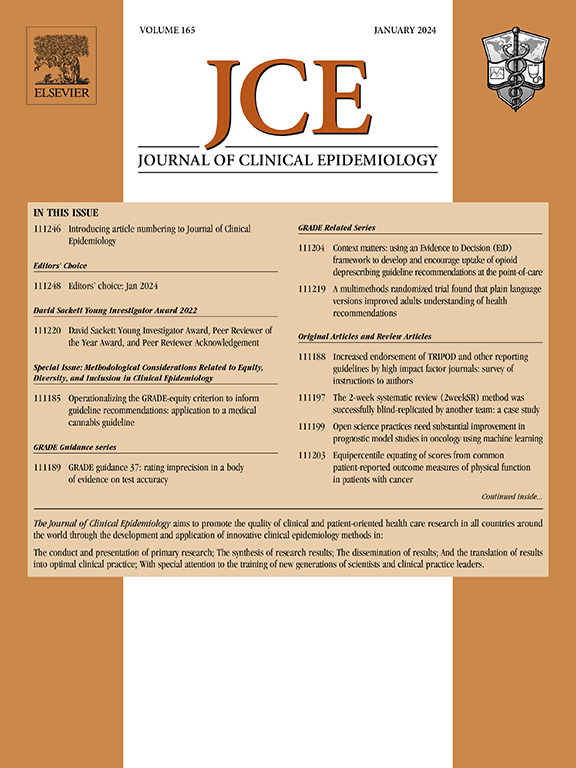严重哮喘生物治疗成本-效果结果的决定因素:系统的方法学评估。
IF 7.3
2区 医学
Q1 HEALTH CARE SCIENCES & SERVICES
引用次数: 0
摘要
目的:评估哮喘生物治疗中成本-效果分析(CEA)方法学特征与增量成本-效果比(ICER)结果和结论之间的关系。研究设计和背景:我们纳入了比较生物治疗和标准治疗的cea,研究对象为患有严重哮喘的成人。我们在MEDLINE、EMBASE和Web of Science(2022年9月)中进行了检索。我们提取并总结了CEA的特征,并使用扩展的共识健康经济标准(e-CHEC)对研究进行了批判性评价。在那些以质量调整生命年(QALY)报告的获益中,我们进行了双变量和回归分析。结果:我们确定了33个cea,总体质量良好(66.6%以上的依从性),在e-CHEC切片中结果不同。我们在分析中纳入了28项关于哮喘生物治疗的成本效用分析(CUA)。只有行业赞助在双变量分析中显示显著差异(ICER中位数差异p=0.021,报告成本-效果百分比差异p=0.027)。在采用非生命周期范围和不使用模型的回归中(β = 4.25和β = 0.16),结论:我们的研究发现了显著的局限性,包括不良的报告实践和行业赞助对结果的影响,对成本效益结论有显著影响。这些发现突出了决策者和医疗保健决策者在经济评估中仔细考虑方法严谨性和潜在偏见的必要性。本文章由计算机程序翻译,如有差异,请以英文原文为准。
Determinants of cost-effectiveness results of biological therapies for severe asthma: a systematic methodological assessment
Objectives
To assess the associations between cost-effectiveness analysis’ (CEA) methodological characteristics and incremental cost-effectiveness ratio outcomes and conclusions, in biological treatments for asthma.
Study Design and Setting
We included CEAs comparing biological treatments to standard care, in adults with severe asthma. We performed a search in MEDLINE, EMBASE, and Web of Science (September 2022). We extracted and summarized CEA’s characteristics and critically appraised the studies using the extended Consensus Health Economic Criteria. In those reporting benefits as quality-adjusted life years, we conducted bivariate and regression analyses.
Results
We identified 33 CEAs that showed overall good quality (above 66.6% of compliance) with variable results across extended Consensus Health Economic Criteria sections. We included 28 cost-utility analyses on biological treatments in asthma in our analysis. Only industry sponsorship showed significant differences in the bivariate analysis (P = .021 for the difference in incremental cost-effectiveness ratio medians, and P = .027 for the different percentage in reported cost-effectiveness). In the regression adopting a nonlifetime horizon and nonuse of a model (β = 4.25 and β = 0.16, P < .05), significantly associated in the multivariate analysis. Only nonindustry sponsorship showed a significant association with the drug being reported as not cost-effective, both in the bivariate and multivariate analysis (odds ratio = 13.2 and odds ratio = 20.15 P < .05).
Conclusion
Our study identified significant limitations, including poor reporting practices and the impact of industry sponsorship on outcomes, with notable effects on cost-effectiveness conclusions. These findings highlight the need for policymakers and health-care decision-makers to meticulously consider methodological rigor and potential biases in economic evaluations.
求助全文
通过发布文献求助,成功后即可免费获取论文全文。
去求助
来源期刊

Journal of Clinical Epidemiology
医学-公共卫生、环境卫生与职业卫生
CiteScore
12.00
自引率
6.90%
发文量
320
审稿时长
44 days
期刊介绍:
The Journal of Clinical Epidemiology strives to enhance the quality of clinical and patient-oriented healthcare research by advancing and applying innovative methods in conducting, presenting, synthesizing, disseminating, and translating research results into optimal clinical practice. Special emphasis is placed on training new generations of scientists and clinical practice leaders.
 求助内容:
求助内容: 应助结果提醒方式:
应助结果提醒方式:


